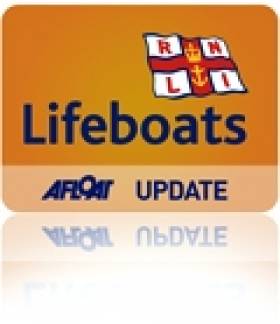Displaying items by tag: Ree
Green Light for Lough Ree Lifeboat
Formal representations were made to the RNLI by the Inland Waterways Association of Ireland with support from lough users and various statutory bodies including the Irish Coast Guard, for a declared search and rescue asset to be present on the Lough.
The charity already operates 43 lifeboat stations around the coast of Ireland and inland on Lough Derg and Lough Erne with around 1,500 volunteer lifeboat crew members. There are estimates of upwards of 1,000 boats moored in or around the Lough, which also has a number of large marinas. The Lough is also a major intersection on the Shannon-Erne navigation route.
The RNLI will initially operate a B class Atlantic 75 lifeboat from temporary station facilities. The lifeboat will come from the existing RNLI relief fleet and a decision will be taken following the year-long trial whether to establish a permanent station.
Martyn Smith, RNLI Divisional Inspector for Ireland, said: 'I am delighted that the RNLI Trustees have agreed to place a lifeboat on Lough Ree. The support and enthusiasm for an RNLI lifeboat on Lough Ree from the Inland Waterways Association of Ireland, lough users and statutory agencies has been enormous. As a charity which relies on volunteers and the generosity of the public we were very impressed with the level of interest and engagement from everyone we encountered.'
Lough Ree is at present the only major lake on the Shannon that lacks a dedicated search and rescue presence. It is the centre for a variety of leisure pursuits based both afloat and ashore and has a significant amount of marine traffic passing through. It therefore makes sense for the RNLI to have a presence here which will see us take local volunteers, train them to the highest standards, provide them with the best equipment and enable them to deliver a life-saving service that Lough Ree needs.'
Initial meetings have already been held by the RNLI locally to gauge interest and support and moves will now be made to recruit the volunteers needed to run the lifeboat station.
View Larger Map
SB3 Hat-Trick for Kennedy on Lough Ree
PRO Vincent Rafter and his team did a great job to get all races sailed in tricky conditions.
Ben Duncan was on fire on Saturday scoring a 1,2,1 with Peter Kennedy scoring a very solid 2,3,2. The conditions on Saturday were mixed with the day starting with 10 to 12 knots of breeze gradually dropping during race 2 & 3. Sunday morning dawned with clear blue skies and sunshine but the breeze built all day to over twenty knots but the last race. Ridgefence started the day with a 1st but Ben was 7th so it was game on for Kennedy.
Doug Smith, sailing with Killian Collins & Mary Creedon on Sacre Bleu, did very well in the breeze scoring a 2,2,4 on Sunday. The building breeze made for some great downwind action as the SB3's took off sailing hot angles. The black flag had to be used on Sunday to put manners on the eager fleet with Ruby Blue (Aidan O'Connell) being caught OCS in race 5 thus pushing him out of the top 5.
Peter Kennedy completed the series with a 1st, and discarding a 5th place, he finished 8 points clear of Ben Duncan on Sharkbait. Ben didn't have his regular crew onboard for the weekend instead sailing with Andrew Vaughan and Joe Turner. Daragh Sheridan, Shane Murphy & John Phelan on Dinghy Supplies had a poor first race but really got going after that with all top 5 places and a first in Race 5. Dinghy Supplies finished joint on points with Doug Smith on Sacre Bleu but Dinghy Supplies got the 3rd place on countback. Darren Martin on Soda Bread from Strangford Lough completed the top 5 positions.
The Silver fleet was decided by removing the top ten boats after the first three races. Colin Galavan on Defiant was 1st, Guy O'Leary was 2nd and Rob Howe on Milvus Milvus was 3rd.
The first lady helm was Selina Dicker on Kicker Off and the 1st Master was Justin Burke on Alert Packaging.
The organisers would like to thank Galway Maritime and English Braids for their kind sponsorship of prizes of sheet sets for the top 3 boats and the winner of the silver fleet.
3500 Ridgefence Peter Kennedy 2 3 2 1 5 1 14 5 9 1
3287 Sharkbait Ben Duncan 1 2 1 7 6 5 22 7 15 2
3490 Dinghy Supplies Daragh Sheridan 15 4 5 4 1 2 31 15 16 3
3164 Sacre Bleu Doug Smith 5 9 3 2 2 4 25 9 16 4
3501 Soda Bread Darren Martin 7 1 8 3 7 8 34 8 26 5
3072 Ruby Blue Aidan O'Connell 3 5 7 9 20 6 50 20 30 6
3548 Flutter Andrew Algeo 6 7 20 6 4 10 53 20 33 7
3323 Alert Packaging Justin Burke 8 6 4 17 9 7 51 17 34 8
3313 Defiant Colin Galavan 11 16 20 10 3 3 63 20 43 9
3226 Quantitive Easing Paul McMahon 4 10 13 12 13 11 63 13 50 10
3281 No Name Guy O'Leary 13 14 12 8 8 9 64 14 50 11
3338 Milvus Milvus Rob Howe 20 11 14 5 10 12 72 20 52 12
3257 Kicker Off Selina Dicker 12 12 6 11 11 13 65 13 52 13
3297 Sunday Brunch Richard Tate 9 8 10 14 14 14 69 14 55 15
3241 Indecision Martin McNamara 10 18 11 16 12 15 82 18 64 15
3165 Sinabhuill Gillian Guinness 16 15 9 13 15 17 85 17 68 16
3320 Smoke on the Water Bob Hobby 14 13 15 15 16 16 89 16 73 17
3315 Sirius Black Ken Hudson 17 17 16 19 17 18 104 19 85 18
3532 Bumble B Fionnuala Loughrey 20 20 20 18 18 19 115 20 95 19

























































